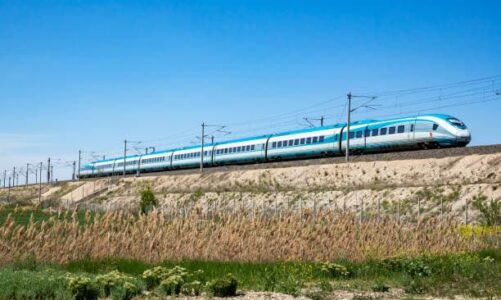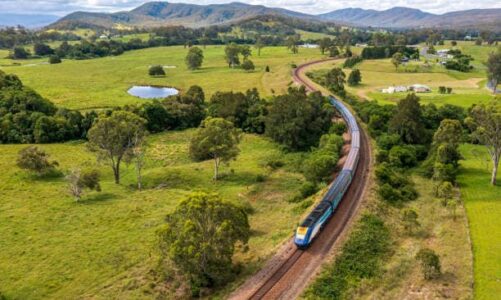It is hard to say who first invented the railroad, or what its progenitor was. The birthplace of traditional railroads is England. It was there in 1804, in Wales, that the first steam locomotive, designed by engineer Richard Trevithick, pulled the first freight train on cast iron rails.
Trevithick’s baton was picked up by his compatriots – the family tandem of father and son George and Robert Stephenson. In 1829 the steam locomotive “Rocket” designed by them reached a speed unthinkable for those times – 47 kilometers per hour.
But America would not be the New World if it allowed itself to lag behind the Old, especially in technological innovation and its application to business. The railroad began to be used in the U.S. in the 1920s of the 18th century and had a very scientific name: the gravity railroad. Simply wooden slats were laid along the side of a mountain or hill and wheelbarrows of building material, wood, or coal were rolled down. The movement was due to gravity – hence the name “gravity”.
But a year before the first “express” went between Manchester and Liverpool, the first real railroad was operating in the United States, in the northeastern part of Pennsylvania. Its name was rather cumbersome: “Gravity Railroad of the Delaware & Hudson Canal Company. The steam locomotive that ushered in the era of real railroads in America was “christened” to match this historic event: the Stourbridge Lion.
The U.S. government provided full support for the development of rail transportation. Subsidies, free allotment of federal land for laying tracks and building relevant infrastructure, organizational and personnel assistance – all this poured down to the railroads as from a horn of plenty.
As the years went by. The railroads not only helped to develop uninhabited territories, but were themselves the most important engine of scientific and technological progress in the United States. Thermodynamics, internal combustion engines, metallurgy, the emergence of engineering disciplines, engineering and metalworking, and even the division of the United States into time zones were all credit to the American “pig-iron.”
From dawn to dusk
It seemed that the development of the railroads was inseparable from the economic and social development of America itself, with only new miles of track, dozens of brand new locomotives, and an increasing number of satisfied customers ahead of them. Confidence that this will be the case has been bolstered by the intense penetration of the railroad into cities and their suburbs. Streetcars, sometimes serving as commuter trains, became as much an integral part of the urban landscape as conventional sidewalks.
World War II strengthened the railroads’ position at the top of the U.S. transportation hierarchy. The main transportation of military equipment, related goods, and troops was by rail.
The situation changed after the war ended. The economic rise in the U.S., coupled with cheap gasoline and the growth of the New World’s wealth, gave such a powerful impetus to the development of the automobile industry that it defined even the internal territorial structure of the United States.
It was thought that automobiles and these highways would make it easy for people to get from one area to another as needed. Americans increasingly began to prefer rubber wheels to iron ones.
The General Motors Corporation, as well as a number of other companies associated with the automobile industry, allegedly already in the 1930s began actively buying up city streetcars, including streetcar infrastructure and commuter electric trains in order to destroy them and thereby facilitate the mass introduction of individual automobiles and city buses into American life.
So, those loads that used to be carried by trains were now dashingly carried along the highways by “eighteen-wheelers”. The benefits, and more importantly, convenience, were evident. Truckers delivered cargo right to the door of recipients, while for the cargo brought by the train people had to go to the station or hire a truck for a “lift”.
U.S. civilian aviation also contributed to the decline in interest in railroads. Mass construction of high-speed comfortable passenger planes together with widespread construction of airports made traveling by rail an anachronism.
It was not a fun picture. By 1965 there were only 10,000 passenger cars in regular service, 85% fewer than in 1929. Freight service, however, was still “afloat” and even brought in some profit.
Government Assistance
Understanding that you can not “put all the eggs in one basket,” even if this “basket” is moved by such a reliable and affordable transport as the automobile, the U.S. government took a rather unique step for him – created in 1971, the state passenger rail company. Its name Amtrak was formed from a combination of two words – American track, which simply means “American track”. Amtrak’s task was to provide intercity services.
The company is directly controlled by the government. Its directors are appointed by the U.S. president, but become so only after approval by Congress. Amtrak retains this status to this day.
To allow the railroads to better “help themselves,” the federal government passed the so-called “Staggers Railroad Act” in 1980. This law effectively exempted railroad companies from antitrust laws, giving them virtually unlimited freedom in setting prices for services, mergers, and consolidations.
But even despite these measures, which saved passenger rail service in America from near oblivion, trains were ringing their horns less and less frequently in the American expanse, and cities forgot the sound of the streetcar bell. The railroads began to be slowly dismantled, and some were so bad that they broke even under the trains standing on them. From the early 1970s to the early 1980s, the total length of active railroad tracks in America almost halved, from 480,000 to 260,000 kilometers.
This was the case until the fall of 1973, when the fuel crisis caused by the oil embargo hit the United States.
Automobiles, trucks and buses, from indispensable and unpretentious helpers, suddenly turned into fuel-eating monsters, capable of eating up a serious hole in the state budget and the budget of a single family.
America seriously thought about an alternative to motor transport. But it took another 40 years, along with a new wave of oil price hikes, for America’s railroads to enter a renaissance.
A real railroad boom began in the United States. According to The Washington Post, while major railroad companies laid off 4,700 people in 2002, they had already hired more than 5,000 employees in 2006. Not only did profits soar, but so did the stocks of these companies. From 2003 to 2008, the total profits of the railroad companies doubled, while the market value of their largest company, Union Pacific, tripled over the same period.
Experts estimate that the total tonnage of rail traffic will increase by 90% by 2035. But in order for this to become a reality, 148 billion dollars will have to be invested in the development of railways. And of that amount, only 96 billion will be spent by private railroad companies. The rest will come from the federal and state governments.
The gradual emergence of the U.S. from the recession brings the demand for railroad services back to the pre-crisis level.



